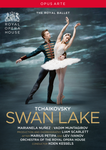|
Back
07/13/2019
Swan Lake
Liam Scarlett and Frederick Ashton [Act III, “Neapolitan Dance”] after Marius Petipa and Lev Ivanov (Choreography), Pyotr Ilyich Tchaikovsky (Music)
Marianela Núnez (Odette/Odile), Vadim Muntagirov (Prince Siegfried), Elizabeth McGorian (The Queen), Bennett Gartside (Rothbart), Alexander Campbell (Benno), Akane Takada, Francesca Hayward (Prince Siegfried’s younger sisters), Artists of The Royal Ballet, Peter Manning (concertmaster, black swan solo), Ania Safonova (concertmaster, white swan solo), Orchestra of The Royal Opera House, Koen Kessels (conductor), Kevin O’Hare (director), Liam Scarlett (stage director), John Macfarlane (set and costume designer), David Finn (lighting designer), Ross MacGibbon (video director)
Live recording: The Royal Opera House, Covent Garden, England (June 1 and 12, 2018) – 151’ (including bonus supplement)
Opus Arte # OA 1286 D (or Blu-ray # OA BD7256 D) (Distributed by Naxos of America) – DTS Digital Surround – Picture format 16:9 – Region 0 – Booklet in English, French and German

   
Since beginning his dance career at age four, Liam Scarlett has also been on a fast track, so much so, that The Royal Ballet’s Director, Kevin O’Hare, created the first Artist in Residence post for M. Scarlett at the young age of 26. Move forward to 2015 when M. O’Hare appointed the young Ipswich native to combine his vision with John Macfarlane’s tangibles. Thus, three years in the making, one can see how politely and well-articulated the two work together…there is a culmination of douceur élégante in this World Premiere production. Furthermore, this aura makes Britain’s Swan Lake one of the most magical and sophisticatedly touching creations in the ballet repertoire.
Liam Scarlett is quoted: “So narratively what I’ve done is we need to pick out these characters we have and it’s making them real, so that the fairy tale world that we go into is believeable.” This is unequivocally true. Not only is Swan Lake tempered in fashion by David Finn’s reaches in lumen perspectives, but it is also the realization of a firmly grounded Macfarlane through sets and costumes.
The scenic backdrops fall into a sort of uneasy friction to support the dance. Act I gives the impression that we’re cocooned inside the era of Nicholas and Alexandra and the Romanov Dynasty. Macfarlane’s moody tension fits a close mold to that of J.M.W. Turner’s Romantic, turbulent landscaping…so idyllic for this ballet. Furthermore, M. Macfarlane likes to use traditional methods to get the effect he wants, though he doesn’t want a ‘stodgy’ look. That is far from the case in this Swan Lake as the first impression breathes eloquence, refinement and sophistication. [To this reviewer the connection turns a bit towards an operatic apportionment (i.e. Eugene Onegin).]
Swan Lake wouldn’t have the emotional imprint without Marianela Núnez...plain and simple. Aided by the sensitivities from Koen Kessels’ pit, Tchaikovsky’s music limpidly elevates the prima ballerina to utmost elegance. “Nuance” has to be one of the best-represented words in Swan Lake. In order to capture this sensitivity, turn to Ross MacGibbon as he focuses on all the subtle expressions arising within the ballet. Not only are Mlle Núnez’s movements fluidly ravishing (her allongés and arabesques flow like gold…she affects bonelessness), her facial expressions build the drama in mere ounces: nowhere do we find a smidgeon of imperfection, rather we regale in a ‘field of dreams’ that catapults us into a galaxy of amazing glory. Odette’s and Odile’s temperaments are unmistakably visible, though significantly divergent. Combined with the youthful innocence of Vadim Muntagirov’s Prince Siegfried, the matching couldn’t be more impeccable [One of the most radiant passages is the Odile/Prince Siegfried pas de deux in Act III.] The slight facial expression emanating from Mlle Núnez as she dies is downright devastating...how can it get any better than this?
Gymnastically-built Alexander Campbell is perfectly cast as the loyal friend to Siegfried, signing in with a snappy, impish personality. While his turns are tight, the pas de trois, featuring Akane Takada and Francesca Hayward, is executed with royal flair.
Liam Scarlett adds his own stamps of embellishment to the œuvre. An example occurs in Act II’s “Coda” [contrast to Tchaikovsky’s 1877 World Premiere Version], whereby an additional stanza is added for Mlle Núnez. The tempo is remarkably diminished (creating a slow-motion effect), though it subsequently (and quickly) builds once again in order to add a final voilà! Superb!
Act III’s character pieces are charming and quintessentially apropos for the orthodox-minded observer. John Macfarlane is perspicaciously grand in the detailing, along with the use of greys, charcoals and burgundy flourishes (tapping into the royal venue). The élan is moody, though opulently dour which fits nicely into the entire ‘picture’. The pairing of Meaghan Grace Hinkis and Marcelino Sambé makes for a light-hearted and delightfully frivolous “Neapolitan Dance”, one that was choreographed by Frederick Ashton: his light-hearted touches bring back the sense of flair he encased inside his La Fille mal gardée back in 2015...the year of this Swan Lake’s inception.
Irrespective of a firm delivery by the corps de ballet and other supporting roles, all eyes will turn on Marianela Núnez. She’s a stunner in the way she connects her footsteps to her hands (yes, especially her hands) to her eyes, and, most importantly, to her heart. It’s all here.
This is one remarkable young lady journeying through Swan Lake. Imperative to watch, to listen...to experience.
Christie Grimstad
|